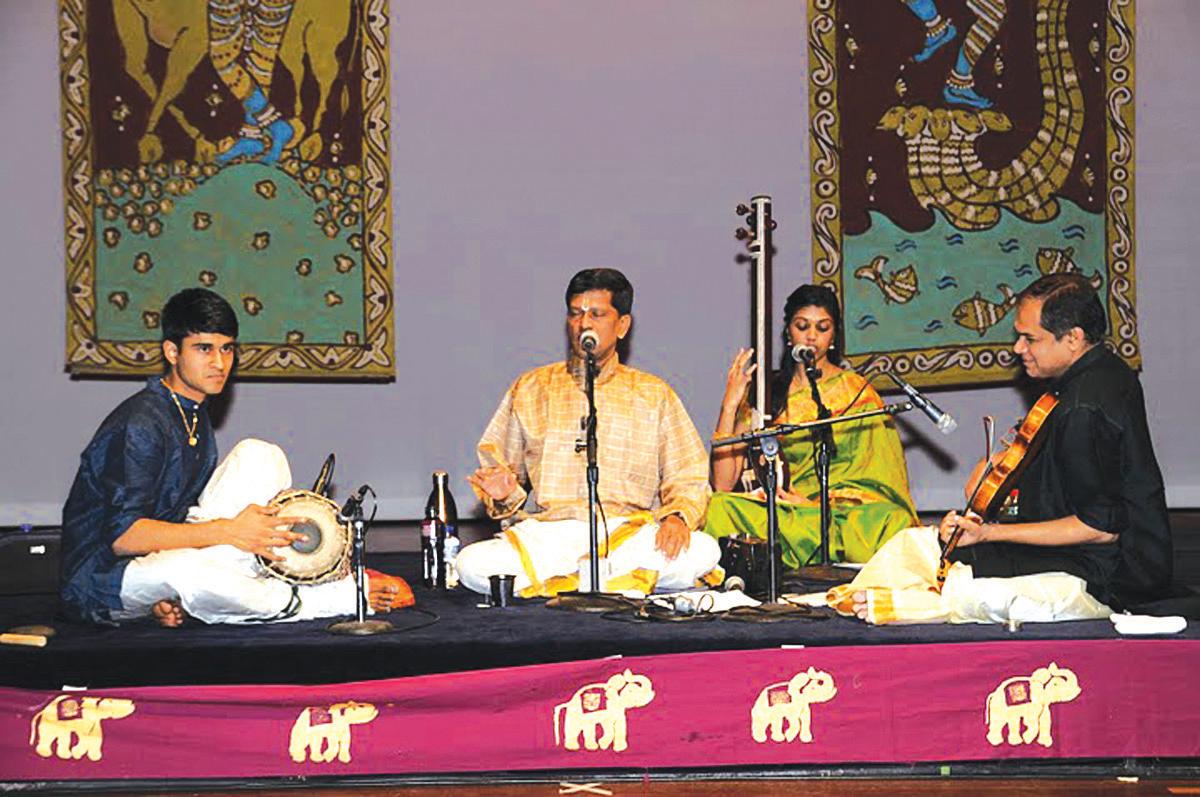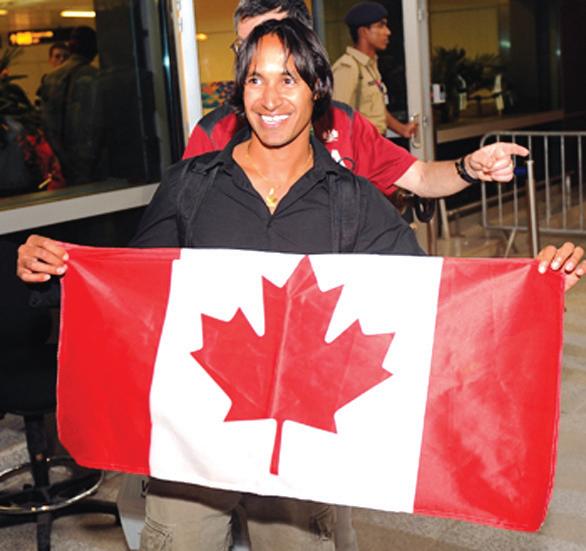
7 minute read
Ghazal ka doosra safar
from 2010-10 Melbourne
by Indian Link
“Ghazal ka ‘pehla’ safar Moghul Empire ke aane per shuru hua”, so articulated Rashid Sultan, Melbourne’s MC extraordinaire, when introducing Ghazal ka ‘doosra’ safar to the anticipating two hundred at a Chisholm Institute hall in Dandenong. Citing Ghazal as an “elegant genre of Urdu poetry where language is more lucid, metaphor simpler and meter less arduous”, Rashid sahib stated that Urdu went through various processes of purification of adjustments and adaptations to finally anchor its place in Indian literature and culture. In this meet, like many others regularly organised by various lovers of Indian culture, Khanak, a yet to be registered group, furthered the discipline that has for long been known as ghazal gaeki.
Under the auspices of Khanak, artists paid homage to Indian music greats such as Kundan Lal Sehgal, Ghulam Ali, Begum Akhtar, Mehndi Hasan, Jagjit Singh, etc. via ghazal gaeki in raags, styles and throats souls absorb best eyes-shut.
Dr. Satendra Mishra initiated the evening by clearing the dust obviously settled over Urdu literate minds since inhabiting English speaking Australia, and elucidated required basic discipline behind Urdu poetry writing. “Verse consists of ‘beher’ (balanced flow),” he related. “‘Matla’ is the opening line, while ‘makta’ the concluding line that may include a poet’s ‘takhallus’ (pen name) Both ‘qafia’ and ‘radeef’ respectively are matching concluding expressions in successively falling verses, e.g., Dil-e-nadañ tujhe hua kya hai! Aakhir is dard ki dawa kya hai?” etc., in tarannum. There were nineteen verse types, he explained, three of which: short, medium and long, are most commonly used. Mid 19th century, Satendra informed, German and Russian cultures adopted the stylish and poignant story telling via the medium of ghazal singing. Sanjiv Naik, a keyboard player of eminence, was introduced, as were Suman Bhattacharjee on guitar, Dhansukh on drums, Robbie Kerr on tabla, Ravi Sharma, visiting Melbourne, on dholak, and others. With“ghazal us ne chheree, mujhe saaz dena. Zara umr-e-rafta to aawaaz dena,” Rashid sahib invited Guru Radhey Shyam Gupta to embellish Kundan Lal Sehgal’s immortal Gham diye mustaquil, kitna taazuk hai dil yeh na jaana. Hai, hai yeh zaalim zamaana, in his rich, deep voice. In his rustic, near-primitive style when compared with present-day Bollywood scores, Sehgal sang this late 1930s. Rashid sahib created a stir by announcing that he had a Gift Voucher for one who would identify one particular song in the first half which was not classed as ghazal. Nearly all who competed were correct. Six year old Sufi picked the winning ticket and Arvind Gaindher was the winner. Seene men jalan, aankhon men toofaan sa kyon hai, Khayyam’s creation sung by Suresh Vadekar was so very beautifully presented by Vinay Samudre; every single murki audibly tackled. Ustad Amin-ul and Nasreen Haque sang a well-rehearsed duet from Anarkali, Paon chho lene do pholon ko inayat ho gi. Relevant details were shown on screen via the powerpoint projection as the artists sang. Quoting Momin, Tum mere paas hote ho goya, jab koi doosra naheen hota! Rashid sahib affirmed that Mirza Ghalib, Momin’s contemporary, are outstanding teachers, reliable, enthusiastic and committed to the cause of their chosen art form. So far, Ramnath and Gopinath have presented five students on the veena and two students on the vocal in full length solo recitals.
The brothers have performed in India, New Zealand, Singapore, USA, UAE and Malaysia. Since 1994, the brothers are annually featured in the December music festival in Chennai, India and have received rave reviews from the press. They have been invited to perform at the prestigious Chennai Music Academy in December.
The Iyer brothers have performed extensively in Australia at various prestigious music festivals across the country, together and with visiting professional musicians from India. They have played with Dr N Ramani, the famous flute maestro and renowned Indian chitravina exponent Shri. N. Ravikiran, among others. Ramnath and Gopinath have released CDs and performed at various temples as well.
The brothers have been classified into ‘A’ graded artists of All India Radio, Chennai since 2009, a rare privilege endorsed on artists residing overseas. The Iyer brothers impart the highest quality teaching, performing and mentoring of this very old and vibrant music form, and the community enjoys the benefit of their talent.
Nearly 180 individuals and organisations received awards in various categories at the ceremony, including several Indian and Sri Lankan origin individuals and organisations. Melbourne based violinist, S Murali Kumar (Indian community), dance teacher Meena Ilankumaran (Tamil community), Eliyathamby Elankumaran (Tamil community), Subra Ramachandran (Indian community), Dinesh Srivastava (Indian community), Victorian Tamil Cultural Association Inc., Sanganaatham Tamil Community Radio (Service Delivery) were among those acknowledged.
Pathmapriya
Yusuf, “because Dev Anand had a lot of hair!” He then presented a rather demanding: Kaheen beqarar ho kar mujhe chhoo liya kisi ne.
Dr. Raman Singh inducted nostalgia with Kishore Kumar’s masterpiece Dil aaj shaer hai, gham aaj naghma hai, sab yeh ghazal hai, sanam, from Dev Anand’s Gambler. Lost-inlove lyricists’ imagination when imbibed with a music director’s myriad remorses, endow Indian music its richness, its diversity. Many hankies were observed touching eyes.
Music Director Roshan who Rashid sahib termed teekha (sharp and emphatic) created his best music on Raja Mehndi Ali Khan’s lyrics, and Monica Bhattacharjee did justice to their combined, rather tricky creation from film Anparh - Hai isi men pyar ki aabroo, woh jafa karen – main wafa karoon. Passionate Vikas Joshi immortalised Mukesh with his Yeh mera deewana-pan hai ya mohabbat ka saroor...
Yusuf Sultan related that his wife insisted he wear sherwani and Aligarhi pyjama since Dev Anand sang Majrooh Sultanpuri and Burman Da’s song in Teen Deviyan in the same attire. “The topi I had to wear,”, claimed
Talented Veena Sholapurkar presented Tu pyar kare ya thukrae, hum to hain tere diwaanon men, from Dekh Kabira Roya. Humble appearing Indu Verma sang Majrooh Sultanpuri’s mourning Madan Mohan furthered pathos to Baharen hum ko dhoonden gi, na jaane hum kahan hon ge, from Baaghi Indu is the artist who one yearns to see seated chandni spread on the ground, chiragh-emehfil in front, and singing this very song with elongated alaaps, strictly only sarangi, sarod and soft tabla necessarily following her command. Shoaib, the last artist, who plays his own harmonium, presented: Koi faryad tere dil men dabi ho jaise, tu ne aankhon se koi baat kahi ho jaise. Shoaib originates from Afghanistan, but is as conversant with Urdu as he is competent in ghazal-gaeki. Young Sabin Riaz accompanying Shoaib is a tabla player courageous to surf beyond the confines of the raagas to excel in his art, was truly entertaining.
From an era that boasted one masterpiece after another, the musical gems presented on the night, made for a truly unique experience.
George Thakur
Ken Pereira: An Indian flavour in the Canadian team
For skipper of the Canadian men’s hockey team Ken Pereira, it is ‘home away from home’ at the ongoing Commonwealth Games (CWG) in New Delhi. The CWG is a double whammy for the hockey player since there is the “excitement” of playing in the birthplace of his parents as well having had the “honour” of carrying the flag of his country during the opening ceremony.

“I’m not at all concerned about talks of security and health hazards. Instead I am expecting a lot of my family members to come and cheer us,” the Toronto-born Ken, who has his roots in Goa, said.
Though 37-year-old Indian origin Ken was born and brought up in Toronto, his parents migrated to Canada from Goa, in the ‘60s. Many of Ken’s relatives are still in Goa while some are living in Mumbai.
Pereira has admitted that he is a bit amused by his identity crisis in India.
Interacting with mediapersons in New Delhi, Pereira joked his way out of the issue by making it clear that he was born in Canada, and has only recently started visiting India.
The veteran player, who hails from Unionville, Ontario, and doesn’t speak Hindi, also said that it is a little awkward when people try to speak with him in Hindi.
“It’s like a Bollywood movie, it’s completely blown up. I’d no idea it would be like this,” Canada’s The Globe and Mail newspaper quoted Pereira as saying.
With over 16 years as a member of Canada’s hockey team, Pereira has a remarkable international sporting career and has earned over 300 caps.
He is widely considered one of the best midfielders in the game.
Ken, who plays professional hockey for a club in Holland, said he was very happy to be in India, the country he had visited on a couple of occasions in the past, the first time during a visit to Chandigarh in 1984 and then during the last World Cup championship.
Ken started his playing career initially in ice hockey which is one of the most popular games in Canada. But he later shifted to field hockey and has been playing the game for the past 17 years. Ken has played more than 200 international matches since his international debut in 1994.
Pereira says he never thought of changing his citizenship to play in India or elsewhere.
“Just being born in Canada, I couldn’t imagine playing for another country,” he said. “Even though (field) hockey is bigger in other countries, I couldn’t imagine putting on another jersey unless it had the maple leaf on it.”
12-year-old aims for gold at Delhi CWG
She studies in Year 8, badly misses her mom, has fallen in love with chicken tikka and naan, and she wants a medal -- not any, but one at the Oct 3-14 Commonwealth Games. Meet Khaaliqa Nimji, all of 12 years, from Kenya, one of the youngest competitors at the Games.
It is a dream come true for Khaaliqa as she marks her arrival on the international stage in India, a country about which she knows little but has taken a liking for its food to such an extent that she has not tried the African and the continental dishes since her arrval at the Games Village.
She is part of a four-member Kenyan squash unit comprising two men and two women.

“It feels great to represent Kenya. I know I am fairly young but walking around with the elder lot does not bother me. I am just thrilled to be here,” Khaaliqa said.
Khaaliqa is the number two squash player








